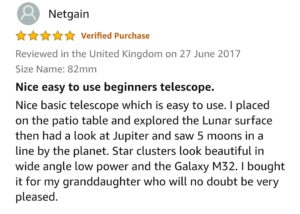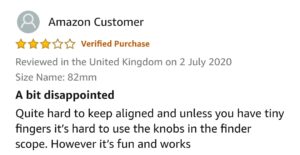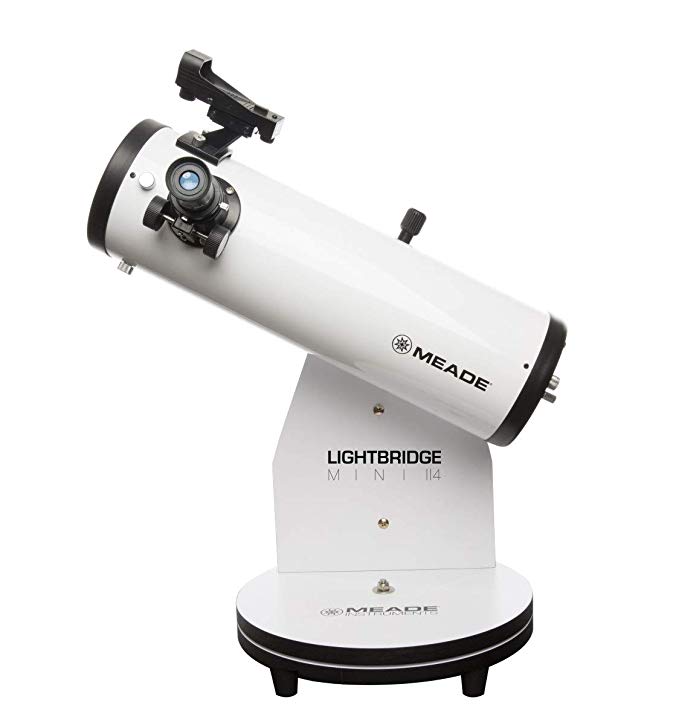*This post may contain affiliate links. This means we may make a commission if you purchase an item using one of our links*
Welcome to my Meade Lightbridge Mini 82 review!
If you’re in the market for an entry level telescope, the Meade Lightbridge Mini 82 is probably one that’s popped up on your radar, which is also the main reason why you’ve found yourself on the review.
This review on the Meade Lightbridge Mini 82 will cover all the core features of the device, the pros, cons and ultimately help you make a decision on whether the device is worth the money or one you should skip.
Overview
Table of Contents
- Full Name: Meade lightbridge mini 82
- Type: spherical mirror
- Aperture: 82mm
- Focal length: 300mm
- Focal ratio: f/3.7
- Dimensions & Weight: 460 x 263 x 209 mm by 1.7kg
- Included eyepieces: 2 MA eyepieces at 26mm and 9mm
- Rating: 2/5
Pros
- Very cheap
- Decent in box accessories
- Very portable
- Easy to set up and store
Cons
- Suffers from fairly intense coma
- Really poor Barlow lens
- Uses a spherical mirror meaning it will be hard to align and focus the mirrors
- It’s discontinued
- Newtonian reflector with a generous 82mm (3 2-Inch) aperture to give you a great view of the moon and planets
- Lightweight (3 8 lbs ) and a compact 300mm (f/3 7) focal length for ultimate portability
- Comes with 26mm (12x) and 9mm (33x) eyepieces for low and high magnification
- Includes a 2x Barlow lens to double the magnifying power of your eyepieces
- 360-Degree swivel mount and a simple point-and-look design for easy use
How Do The Meade Lightbridge Mini 82’s Optics Work?
The optics used within the mini 82 are reflector based and of the fairly cheap and quite hard to collimate spherical design. What this means is that you’ll be hard pressed to see very clear images of any celestial objects when looking past a certain magnification limit.
This of course does limit the devices overall ability. Then again considering the device can be had for around $60 it shouldn’t really be the biggest of deal breakers for the average user.
That being said I’ll go over all of the other pros and cons of the reflector optics inside the mini 82 starting with the pros :
- Great for viewings faint objects in the sky as all types of light can pass through the lenses (this isn’t the case for a refractor)
- These are generally cheaper to manufacture, resulting in cheaper telescopes.
- These optics don’t suffer from chromatic aberration
As for the cons, they are as such :
- The optics are exposed meaning you’d need to clean them up regularly
- You’ll regularly need to collimate the device too as they’re easy to knock out of alignment
- Low focal ratio reflector devices tend to suffer a lot more from comatic aberration
- Can’t view things on earth very well unlike the other 2 variations
- Spherical optics suffer from spherical aberration resulting in a lack of focus and clarity
What Do The Meade Lightbridge Mini 82’s Specifications Mean?
The Mini 82 has an aperture of 82mm, a focal length at 300mm resulting in a focal ration of f/3.7. This means that the device won’t really be great at focusing on singular objects like planets and should theoretically be able to achieve a max magnification of 160x.
Of course the spherical mirror does mean that actual usage will be limited particularly when it comes to sharp views and the lower focal ratio also means coma will be quite prevalent when looking through the lens.
Nevertheless, the mini 82 should still allow you to see the following celestial objects :
- The moon and its craters in reasonable detail
- Jupiter in reasonable detail
- Saturn and an outline of its rings near max power
- Mars, Mercury and Venus should be visible although not in much detail
- You should be able to make out some star clusters, a few galaxies as bright dots and maybe some asteroids if you’re able to track them and if they’re near enough to you.
Regarding the mini 82’s dimensions and weight, it’s dimensions are 460 x 263 x 209 mm whilst it appears to come in at a very lightweight 1.7kg. It should go without saying that this will be very easy to carry or store for more or less anyone interested in the device.
Accessories Included In The Box
The accessories included in the mini 82’s box includes 2 MA eyepieces at 26mm and 9mm, a red dot finderscope, a 2x Barlow lens, a plastic 1.25” rack-and-pinion design focuser and a bunch of other miscellaneous documents.
The eyepieces are most certainly passable for the price tag, the Barlow lens is of a very low quality, the focuser and finderscope is also passable for the price. In short I wouldn’t really classify the accessories as poor considering the price however, if you do want to get the most out of the mini 82, upgrading to better eyepieces wouldn’t be a bad idea.
The Meade Lightbridge Mini 82’s Mount
One of the more interesting things about the mini 82 is that the mount (which is a simple tabletop alt-azimuth mount) is directly attached to the tube with a bolt and not through a vixen dovetail attachment. This means that you probably won’t be able to attach the the device to a tripod. This is simply a compromise you’d need to make.
First of all you should know that the mount is made of particle board which means that it can be susceptible to rotting if not looked after probably. If that’s an issue for you it’s definitely worth looking into fixing that by creating your one plywood board instead.
As for how the mount functions, it’s pretty much the same as the mini 114 and mini 130 besides the size difference meaning it uses 3 small teflon pads that attempt to create a smooth turning motion on the singular bolt that the mount is attached at. This should make for a fairly decent viewing experience.
However, as it is a table dobsonian and the device itself is quite lightweight, the viewing sessions won’t always be the most stable.
What Are Users Of The Meade Lightbridge Mini 82 Saying
As the device is quite cheap, it does of course have its fair share of manufacturing issues and the spherical mirror does limit the clarity of images that can be seen.

However, at this price range you shouldn’t really expect the clearest of views and those who go in with the expectation of not necessarily getting the best views generally seem to enjoy it.

Other Alternatives Worth Checking Out
At this moment in time it will likely be very hard to find a new model mini 82 due to it officially being discontinued by meade. Nevertheless, if you’re a beginner level astronomer that’s willing to extend their budget into the $150 range or even the $200 range I can suggest you few alternatives.
The Zhumell Z100 or the Z114 are great options as is the SkyQuest XT4.5. So, if you’re still in the market for a first time telescope like the mini 82, either one of the aforementioned devices should be decent for you.
Summary
Although the Meade lightbridge mini 82 has its fair share of shortcomings and is at this moment officially discontinued by meade (although there should still be some models floating around) if you can pick it up for it’s roughly $60 – $70 price tag, it most definitely will deliver, especially if you just want to be able to see up till jupiter whilst retaining solid portability.
At that price range and or of you just want a very basic telescope, the mini 82 is perfect however, if you want to broaden your horizons, one of the bigger and more capable devices I mentioned above are what I would recommend instead as the mini 82 isn’t really that great as a whole.


